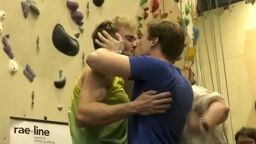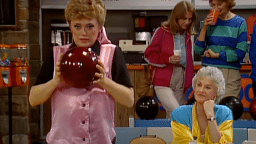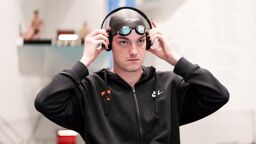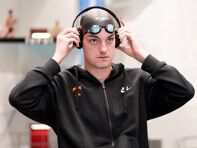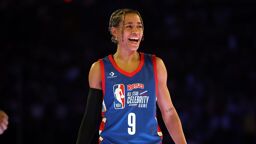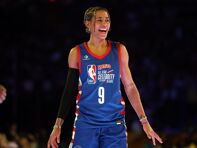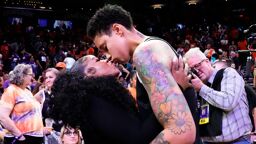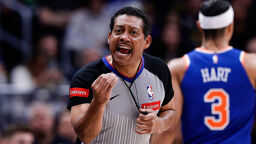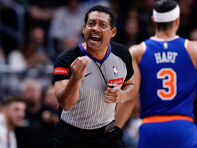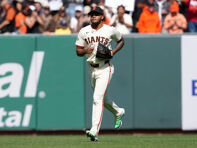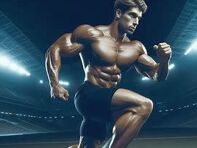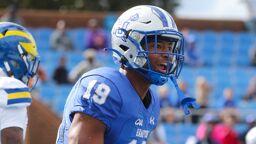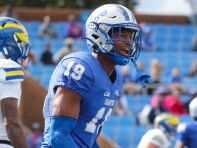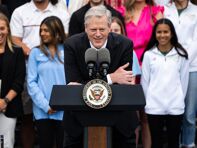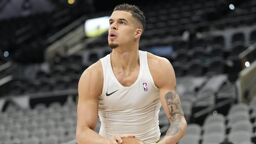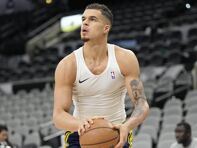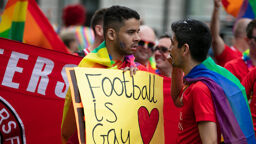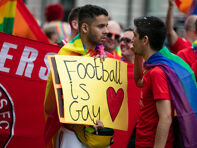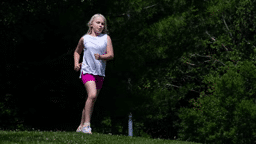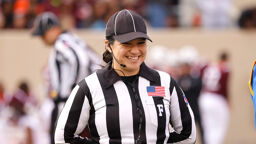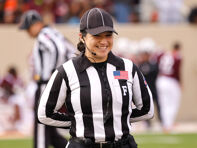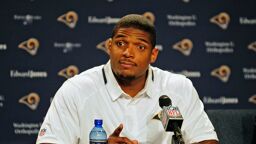Rebel hoofprints through the rodeo arenas
By Patricia Nell Warren
Special to Outsports.com
As spring comes on, basketball people start thinking March Madness. Baseball people start thinking training camp. But rodeo people start thinking new belt-buckle trophies. The International Gay Rodeo Association season starts in January and goes through 22 rodeos in a dozen states, winding up in Denver for IGRA National Finals in October. Our women in boots and big hats will be busting bulls and broncs – things that females aren’t allowed to do at the “mainstream” National Finals in Las Vegas the same month.
Like many sports, rodeo is still obsessed with the ruggedly masculine. Yet in the sport’s beginning, women actually enjoyed some equality — along with a little room for unconventional gender profiles. Indeed, rodeo, and the LGBT people in it, has a history of bloody battles about “gender appropriate” events and dress code.
As a member of a family that spent four generations on a Montana ranch, I competed in high-school rodeo as a teen. Coming out, I realized that secret lesbian stories could unfold both on a ranch and in the arena. But these are very different stories than the cowboy love in “Brokeback Mountain.”
Early days
Rodeo grew out of the vast livestock industry west of the Mississippi. But cowgirls had a different role in that industry than cowboys did. “The boys” were employees — working stiffs who populated ranches by the countless thousands. “Boy” referred to your lowly and possibly non-white social status. Cowboys did the dangerous horseback work that the “cowman” or owner needed done. But ranches never hired women to do those jobs.
 |
| Jennifer Vrana, winningest cowgirl in gay rodeo history |
Instead, women’s role in rodeo grew out of the owner side of ranching. My dad set me straight on the subtleties of the terminology, when he was educating me on the possibility that I’d run the ranch some day. “You’re not a cow girl,” he said pointedly. “You’re a cow woman.”The roots of “cow woman” and “cowman” go back into the Spanish-speaking regions of colonial North America, especially California during the 1697-1848 period. Ranches were created out of vast land grants given to families that emigrated to the New World. Wives co-owned the ranchos with their husbands. Under Spanish law, a man’s inheritance went to his widow, not his oldest son as in English law. Land ownership elevated a couple to gentry, so the ranchera and her husband were styled Doña and Don, the equivalent of England’s madam and sir. Whereas the working help (who were often Indians) were called vaqueros (cow boys).
Historian Kathy Hughart writes: “As husband-wife partnerships became stronger through joint ownership of ranch lands, women experienced a new kind of power, freedom to enter the world of men's work.” Spanish California women virtually lived on horseback, since equestrian skills were part of upper-class social life. Even on the bigger ranches, a crew of well-born rancheras – the wife and her daughters — might show up at round-up time to help brand or ship the cattle. Hughart relates: “Foreign visitors marveled at California women's horseback riding skills and expertise with the lasso.”
Rancheras also turned out for fiesta-type affairs that evolved out of the rodeos, or roundups. After the United States grabbed California and the Southwest away from Mexico in 1848, these ranch fiestas survived.
In the eastern Anglo colonies, where law traced back to England, things developed differently. After the American Revolution, the new state constitutions restricted voting rights to property-owning white Christian males. Women weren’t free to own land till the Homestead Act of 1862, which the federal government passed to speed American occupation of Western regions that might still be grabbed by the British or Russians. This act put millions of low-income owners on 270 million acres by the early 1900s. To claim a 160-acre parcel, a homesteader had only to be a head of household and 21 years old. So an unmarried woman or widow could stake out a homestead.
Land ownership shot new life into the women’s suffrage movement. Not surprisingly, the first states to let women vote were Western states. In turn, land and suffrage touched deeply into other areas of women’s sensibilities – including gender identity and sexual orientation. We can only guess how many of these female homesteaders were closet cases of the Victorian era – women who aimed to escape the church-driven strictures of daily life “back in the states.” Women’s westward spirit was movingly expressed by closeted lesbian novelist Willa Cather in her novels O Pioneers! and My Antonia.
If a cow woman was wealthy enough, she didn’t have to wrestle around with the livestock – she could hire cowboys to do that. But a cow woman of more modest means couldn’t afford to pay cowboys. At most she might hire a hand or two at roundup time. For the rest, she (and her sisters or daughters, if she had them) did their own work — harness and drive a team, rope steers, cut cows or calves out of the herd, do branding, and sit a bucking horse on a cold morning.
Some Western women did crash the male employee world – but they did it in other professions, by wearing men’s clothes and passing as men. Some were evidently lesbian or bi women or FTM transgendered people. One-Eyed Charlie, a well-known stagecoach driver, was discovered (after death) to be a woman. Some passing lesbians actually married the women they loved – as did Oregon pioneer Lucille Hart.
To fight the trend in some localities, Bible-thumping moralists cited the Old Testament prohibition of cross-dressing, and passed laws making it illegal for women to wear trousers and other men’s clothes.
That's entertainment
Through the late 1800s, ranches and communities started staging the first organized celebrations of ranch sport. At first these were called “stampedes” or “roundups.” Later everybody opted for the Spanish term – rodeo.
Rodeo, and women’s role in it, got its biggest push from the Wild West shows. In 1883, frontiersman-turned-promoter William “Buffalo Bill” Cody brought international popularity to ranch sport when he added it to his show — the biggest and most successful traveling entertainment enterprise in American history. With the Indian wars finally over, the “Old West” was sufficiently tamed that it could be packaged as circus for city people – featuring appearances by famous figures like Lakota chief Sitting Bull and mountain man Liver Eatin’ Johnson.
Along with re-enactments of battles and stagecoach robberies, Buffalo Bill created sport competitions based on ranch skills, showing how women as well as men lived the frontier spirit. So the shows created a female class of employee entertainers with cowboy skills, who were dubbed “cow girls.” The “girls” roped steers, topped broncs, did relay races and trick riding, often competing directly with cowboys. Out of respect for Victorian dress code, they often rode sidesaddle. If they rode astride, they wore voluminous skirts or circusy costumes that were actually a safety hazard. Other Wild West shows followed Cody’s formula.
The term “cow girl” had a less respectful ring than ranchera or “cow woman.” In those days, society looked down on entertainers — circus acts, dance-hall girls, vaudeville and burlesque performers, theater artists, early film stars, etc. – considering them to be bohemian types who led irregular and immoral lives. So, despite their efforts to look ladylike, the women riders who worked for the shows were grouped as hired bohemians along with the “cowboys.”
"That awful girl"
Between 1884 and 1901, one of the West’s most notorious gender-bending women was a Wild West star. She would cast a long shadow down the history of rodeo.
Born in 1856 to struggling pioneer parents, Martha Jane Canary was orphaned at age 13. Though her life was later colored by legend, it was actually “a bleak story of poverty and alcoholism,” according to historian James McLaird, who sifted patiently through frontier records to write her definitive biography. But we know one fact for sure: Martha defied convention on the gender frontier. A pretty but tough brunette girl who fended for herself and wore men’s clothes as a young teen, she was dubbed Calamity Jane.
For 30 years, Calamity led a transient life around the boom towns of the West. Her favorite hang-out was Deadwood, in Dakota Territory. In 1875, when she was 19, the U.S. Army was still fighting the Plains tribes. Several times Calamity put on uniform and smuggled herself into army expeditions as a camp follower. There she was the soldiers’ pet, and mastered skills that would later be important in the arena – horsemanship, firearms, and driving a big wagon team so expertly that she could reportedly knock a fly off a mule’s ear with her long bullwhip.
Calamity loved to make a grand entrance into Deadwood, riding down the main street in fringed buckskin jacket and breeches, her hair all windblown under her campaign hat, with pistols in her belt and a Winchester rifle across her saddle bow. Already a heavy drinker as a teen, she became a familiar figure in saloons west of the Missouri. Far from resenting her invasion of their domain, most of the male drinkers liked her – she was entertaining, funny, generous and kind (when she wasn’t pissed off).
As her reputation spread, newspapers started logging her movements around the West. It was news when Calamity Jane rolled into town. One newspaper editor called her “that awful girl.” It’s a wonder she was never lynched. But she had her friends in high places, plus civic good will that she’d built by nursing sick people during the West’s frequent epidemics. The worst punishment she suffered was a few days in jail, or being asked to leave town.
From the headlines, Calamity moved to celebrity status in author Edward Wheeler’s popular dime novels about the West. He made her one of the first pulp-fiction heroines…and never paid her a nickel of royalties.
Indeed, the real Calamity was often borderline indigent. Yet she worked hard at a living – first as a prostitute and dance-hall girl, later as a teamster, gambler, faro dealer, bartender, nurse, cook, waitress, laundress. She made a few abortive efforts at small business – brothel, saloon, roadhouse, restaurant, small ranch. Her two marriages and several cohabitations with men may have been efforts to find shelter when she was broke. Later in life, she capitalized on her celebrity by publishing a pamphlet autobiography and doing lecture tours, where she told tall tales about her life, and sold the book and photos of herself. But in the end, most of the money she made went into drinking.
 |
| 1920s champion Bonnie McCarroll bucks off. She was later killed by a bronc. |
Can historians peg her somewhere in the LGBT acronym? We can’t. But the Westerners of her time knew she was “different.” Cross-dressing alone was viewed as unnatural by the Victorians. Was she a lesbian? One newspaper writer called her a “queer freak of nature.” Another called her “a pupil of the Oscar Wilde school of esthetics,” which skated close to saying she was gay, since British poet Wilde was known to be homosexual. For a year during her army time, Calamity had a teen female companion named Little Frankie O’Dare, who may or may not have been her lover.
Perhaps she was bisexual. When she was young, she often arrived at a dance-hall in bowler hat, black tie and tails, and danced the Virginia reel with the girls for part of the evening. Then she’d return later in female evening wear, complete with feather boa and fancy hat, to dance with the men. In his 1990 novel Buffalo Girls, Larry McMurtry (co-writer of the Brokeback Mountain screenplay) portrays Calamity as a hermaphrodite. I doubt she was, since most intersex people are unable to have children. Historian McLaird establishes that Calamity had a daughter and son, but she let them be raised by others.
In my opinion, her intense identification with men – notably her handsome drinking buddy Wild Bill Hickok, who was shot to death in a Deadwood saloon in 1876 – may send the message of a gender-identity issue. While she never tried to pass as a man full-time, Calamity embraced the frontier man’s habits – hard drinking, cigar smoking, colorful swearing, loudmouth bragging, card playing, gun slinging, fist fights. And she kept these habits even when wearing women’s clothes. In her autobiography, she wrote, “I was at all times with the men, where excitement and adventure was to be had.”
We do know a second fact about Calamity. Because of her celebrity, the Wild West shows saw her box-office potential. Indeed, Calamity sought jobs with the shows because the pay was good. One of her legends says she toured with Buffalo Bill’s show. There’s no evidence for this, but Calamity did appear with other productions. In 1884, at age 28, she joined Tom Hardwick’s Great Rocky Mountain Show. Society flocked to see the infamous frontierswoman galloping astride in men’s buckskins, doing her target shooting and bullwhip cracking. Essentially they saw Calamity as a freak show.
In 1901, at age 45, Calamity made her most unforgettable appearance at the Pan-American Exposition in Buffalo, New York. There, in the Fred Cummins show, she was lionized by high society at a formal dinner. The big arena drew 25,000 spectators a day. For a time the show managed to curb her drinking, and she wowed the crowds with her riding and rifle handling. On July 31, in the parade down Buffalo’s main drag, Calamity provided a unique spectacle as she drove a 100-mule team pulling a big water wagon. An Exposition photo caught her in a backstage moment. It’s a poignant image — the bronzed woman with the haggard boozer face, sitting a horse in her buckskin regalia – looking older than her 45 years.
Then Calamity fell off the wagon and quit the show. By late 1902, she was back in Dakota, suffering the terminal effects of alcoholism. Despite the care of friends, she died in July 1903.
Her funeral was the biggest in Deadwood history. At her request, she was buried in a man’s shirt, near Wild Bill Hickok’s grave. She was only 47.
Damsel doggers
Calamity Jane may have gone to the great arena in the sky, but her reputation — and the issue of appearing feminine — stayed around to haunt rodeo cowgirls for the next hundred years.
During the 1884-1920s heyday of the Wild West shows, more than 100 women contestants a year were still competing with men in the rough events – saddle bronc riding, steer roping, bull riding. At that time the Olympic Games had just ouchily agreed to allow female participation, but only in “ladylike” non-strenuous sports.
Around 1920, rodeo started to part company with the Wild West shows and establish its own identity. It did keep the circus MO – the grand entry, the glitter, the trick riding and fancy roping, even the clowns. Major Western cities produced their own annual rodeos. An annual circuit sprang up, with championship finals in Madison Square Garden in New York. Contestants were no longer employees, but free agents — yet they were still called cowboys and cowgirls. Since ranch life abounded with hard-working women, most people still had no objections to females competing with men. Indeed, rodeo cowgirls were not at an athletic disadvantage with cowboys — many events require both genders to have a lean light build, good balance and quick reflexes.
A hairy new event called steer wrestling (aka chute dogging) had been invented. You slid off a galloping horse onto the back of a galloping steer, grabbed his horns and twisted him to the ground. One of the first and best damsel doggers was Fox Hastings. She got her start in the Irwin Brother’s Wild West Show, doing bronc riding and trick riding. After she married bulldogging star Mike Hastings, she took up dogging herself, and set a new world record in 1924 at the Houston rodeo.
By the 1920s, however, rodeo management was pressuring cowgirls to appear more “womanly.” With safety in mind, the women had shed those long Victorian skirts. But management had made it clear that men’s trousers were not an option. So the women rode in split skirts or bloomers. Not till well into the more liberal 1920s did cowgirls start wearing pants in the arena – everything from corduroy trousers to eastern-style jodhpurs! Eventually the trend dictated a Western-style dress pant tailored to fit the female body.
Through the Roaring Twenties, while many Americans explored bathtub gin and sexual liberation, male rodeo organizers grew ever more hostile to a Calamity Jane type of image. As a cowgirl traveled the circuit, it was now risky for her to be visibly unmarried. She either had to have a chaperone, or get married. The most diligent historian of women’s rodeo, Texas author Mary Lou LeCompte, briefly discusses today’s homophobia towards lesbians in other sports, but she insists that almost all those old-time rodeo cowgirls were married and genuinely womanly (translation: heterosexual).
Another issue was the “unseemly” spectacle of women being thrown. Many rodeo producers started prohibiting women from riding “slick” (with loose stirrups) and made them tie the stirrups down. Supposedly this was safer. Actually “hobbled” stirrups were more dangerous.
Playing it safe
Despite this hostile trend, national women’s bronc-riding champion Bonnie McCarroll of Idaho was one of the brightest cowgirl stars through the 1920s. She also signalled the striving for greater “femininity” in her image. Petite, dark-haired, blue-eyed, Bonnie won her title at Madison Square Garden in 1922.
Like many female contestants, she married a rodeo cowboy. The circuit’s nomadic life made it impossible to have a fixed year-round residence, so your best chance at a stable relationship was to marry in the sport. Besides, a non-cowboy husband might not like to see his wife ass-up in the air as she bucked off a horse. But Bonnie felt compelled to say things to the media like, “I like my home. I like pretty clothes. I like to sew and do all sorts of feminine things.” Her husband, Frank McCarroll, told the press that Bonnie was "the best little cook in the world and some dressmaker, too."
Then at the 1929 Pendelton Roundup, Bonnie drew a bronc named Black Cat and came out of the chute with her stirrups hobbled. The horse somersaulted and one of Bonnie’s feet got caught in the tied-down stirrup. Black Cat scrambled up and ran, dragging and kicking her horribly. Bonnie died in the hospital of massive head injuries.
McCarroll’s tragic death provided the excuse that the rodeo establishment was looking for. Instead of accepting responsibility for having imposed the hobbled-stirrup rule, pro rodeos began barring women from competition. The trend was accelerated by Western movie actor Gene Autry, who became a nationwide power in rodeo production. Autry felt strongly that woman’s place was in the home – a view that was painfully visible in how his films portrayed females.
By World War II, cowgirls were barred from everything but the “safe” stuff like trick riding competitions and rodeo queen. They became the rhinestone hatband on the Stetson of rodeo life. With all that massive pressure to conform, any lesbian or bi women who had been quietly doing the circuit were probably buried deep in cover marriages by now.
During World War II, some out-of-work cowgirls went to work in the defense industry. When the war was over, they were in no mood to continue sitting on the fence. By 1948, they had declared war on the male-dominated establishment by organizing the Girls Rodeo Association. They fanned out across the country, promoting a hot new sport called barrel racing, aiming to get back in the professional arena. GRA also staged all-women rodeos where females competed boldly in all the standard events.
The most celebrated of these post-war activists was Alice Greenough, women’s world champion bronc rider. Alice and her sister Marge – along with their brothers Turk and Deb, also champions – were the second generation of a Montana rodeo dynasty.
Alice Greenough may have toed the line on cowgirl glamour. But in a time when most women’s career choices were limited to secretary, nurse, teacher and housewife, she lived a fast and exciting life that Western teen girls of my generation could only dream about. She and her siblings had actually been to that fabled place called Hollywood, where her brother Turk married the famous fan dancer Sally Rand and Alice did stunt riding for the movies.
In fact, Alice had been married and divorced not once, but twice. Divorce was still a shocking new thing in those days. So the very mention of Alice’s name gave us ranch-country girls some delightful bohemian shivers.
Hometown rodeo gals
Around 1949, when I was 13, Alice Greenough made an unforgettable appearance at my home-town rodeo. She had formed a rodeo production company with cowboy colleague Joe Orr.
Deer Lodge (pop. 6000) sat in the heart of western Montana pioneer cattle country, and had held a rodeo every year for almost half a century. Local promoter Tony Sneberger, who owned the Corner Bar in town, was also chairman of the Powell County fair board. He produced the big event in August – county fair, livestock show, race meet and a world-championship rodeo. When the Girls Rodeo Association lobbied Tony about putting a GRA event on his program, they found him to be an open-minded guy. He also owned racehorses and had just hired Janet Thomson, one of the first female racing trainers.
So Tony contracted the Greenough-Orr outfit for his show.
The Deer Lodge fairgrounds sat amid stately cottonwood groves alongside the state highway north of town. On the rodeo’s opening night, the grandstand was packed, with the smell of hamburgers and beer drifting from concessions under the stands, mingling with the earthy odor of horse and cow manure from the brightly floodlit arena. All the big names were there – Deer Lodge was the next stop on the world championship circuit so everybody was gunning for points. As men saddled broncs in the row of chutes, it was time for Alice’s exhibition ride — with stirrups hobbled.
The announcer’s circusy drawl echoed around the fairgrounds: “And noooow, ladieees and gentlemen, coming out of chute number 4, we’ve got Alice Greenough of Rrrrred Lodge, Montanaaaa …..!”
Sitting in the grandstand, my girlfriends and I were beside ourselves with excitement. We represented several ranch families and horsy town families, and were dressed to kill in our best Stetsons and dress pants. Our hand-embroidered cowgirl shirts — a fashion rage then – were made by our mothers or ourselves. Our eyes were fixed on Alice’s big Stetson, which was barely visible over the top of the chute.
Then Alice yelled “Outside!” and the gate swung open. The bronc burst out in a frenzy of sunfishing and corkscrewing. Alice rode him for the eight seconds in her Hollywood cowgirl shirt and tailored pants with sequins and beading. Her hat didn’t even fly off. As she made a flaming, flashing spectacle in the floodlights, we girls cheered ourselves cross-eyed.
Later in the program, Alice was back with other mounted cowgirls, for the first barrel race we had ever seen. The arena crew set up a triangle of three 50-gallon drums in the arena. One by one, the girls rode wildly against the stopwatch, making a cloverleaf pattern around the barrels, with their galloping horses leaning at a 45-degree angle as they “pocketed” each barrel in explosions of flying dirt. It was spectacular, and the crowd loved it.
Those three days were heady stuff for little ole Deer Lodge. In the evenings, every bar and restaurant filled up with hard-drinking contestants and fans. The local “chippies” worked on getting a rodeo cowboy in bed before the end of the night. My star-struck posse and I were allowed by our parents to hang out at a popular family steakhouse, the 4-B’s Café. The place was more crowded than a Hollywood red carpet, the air chokey with cigarette smoke. Couples were slow-dancing by the jukebox with Patti Paige wailing “The Tennessee Waltz.” It was easy to rub elbows with the rodeo greats – they weren’t walled off behind bodyguards and publicists as celebrities are today. I vividly remember the moment, as I sat at the counter, when the legendary Jim Shoulders, all-around world champion, slid onto the red leather stool next to me and solemnly ordered a hamburger.
Nearby Alice and Marge were talking to some people, dressed in formal cowgirl wear for the evening. I vividly remember being too shy to ask Alice for an autograph.
Barrel racing at the grassroots
As barrel racing became popular, we local ranch girls had no idea that we were seeing sports history happen.
Today girls and women who want to get into Western-type horse sport have quite a few choices. These include barrel racing, endurance races, reining and cutting competitions, team roping, team penning, and o-mok-see, which is native American games on horseback. But in those post-war years, barrel racing was it, and GRA promotion made it the hot thing to do. This explains why most of my girl posse and I grabbed our horses and started practicing.
My best buddy, Shirley Sexton, and I had a friendly competition going. Shirley was feminine, petite, the town beauty – rodeo queen, prom queen, cheerleader, etc. – and also an excellent rider on her half-Thoroughbred mare Fancyfoot. I was the rugged unpetite tomboy who loved grungy levis. My mom battled to get me into dresses. So we compromised and I agreed to go the Alice Greenough route of “nice” cowgirl wear.
At the championship rodeo, the barrel race was reserved for GRA professionals, so we couldn’t enter. But Tony Sneberger, ever the forward thinker, had reserved the first day of the fair for another new thing — the 4-H or high-school amateur rodeo – and he made sure that girls were welcome. Most rural kids in the county belonged to 4-H, and I was president of my own club, the Powell Champs.
So we all turned out for this watered-down version of adult rodeo. It was boys only in the bareback bronc riding and steer riding – and the animals weren’t very big or rank. Girls only in the barrel race. But males and females went head to head in the rest of the events, like breakaway calf roping and o-mok-see. So we girls got half a chance to beat the crap out of the boys.
Dress code was less strict at the 4-H rodeos – but we tried to look as flashy as our Hollywood heroines. My favorite outfit was a turquoise suede fringed jacket and turquoise Stetson, a silk neckerchief, Justin boots and those tailored Western pants.
I was typical of those first amateur barrel racers, with my Palomino cow pony, Gold Dust. My dad set up practice barrels in a corral that wasn’t used much. Gold Dust wasn’t exactly a speed horse, so I appropriated the ranch’s bay Quarter Horse mare, Molasses. She’d been bought for working cattle but she was fast and game. Molasses carried me to my first and only belt buckle as best all-around cowgirl of the Powell County 4-H Rodeo. This was around 1951.
But the idea of being a cow woman – and cow girl – was destined to fade. By the time I left Montana for college in 1953, my career choice was writing and publishing. Shirley opted for a career as a top-flight surgical nurse. (She and her doctor husband are retired on an Oklahoma ranch today, and we’re still friends.)
During those heady years, I ran into a few other tomboys, but never heard the word “lesbian” alleged about any local girl … or any of those bohemian gals who came to town with the rodeo. The L word was not one that “nice” people used. The few females who made blips on my gaydar screen were surely living deep in the same leather-lined closet I was in.
The Fifties and Sixties would be called the Golden Age of Rodeo, as the sport went heavily professional and sponsor-driven, with rich prize money and eventual popularity on TV. Women’s barrel racing became a standard event, with the GRA giving way to the Women’s Professional Rodeo Association. To this day, WPRA is the oldest organization of female pro athletes in the U.S., and the only one that is run entirely by women.
Among the star barrel racers of the Sixties was Donna Alverson, whom I met in the early 1970s after I became a Reader’s Digest book editor. Donna came to the Digest with a vivid fiction manuscript that drew on her hard knocks in the sport. I helped her get the novel in publishable shape. Drum Runnin’ Fool saw print in 1976, two years after I published The Front Runner. It would one day be viewed by many as the best book about barrel racing.
Rainbow rodeos
That same year, 1976, the first gay rodeo dramatically broke the mold of the old machismo. Its sequin glitter was borrowed from the Imperial Court.
In Reno, the Emperor of the local Imperial Court, Phil Ragsdale, had proposed putting on a gay rodeo to raise money for the Muscular Distrophy Association. The idea was to show straight folks that gay people care about the communities they live in. Ragsdale and others formed the High Sierra Rodeo Association. Since Western homophobia lies heavy in Nevada, Phil had a hard time lining up some rodeo stock and a venue. But finally his show came off at the Washoe County Fairgrounds on October 2 and raised thousands of dollars for the charity.
Today gay rodeos are not officially professional, though they go the well-worn commercialized route, complete with Budweiser sponsorships. Yet they’re seldom televised except on Free Speech TV. Many contestants are so serious about pursuing the IGRA championships that some complain about gay rodeo getting “too professional.” Yet these shows do remain amateur, populist and community-spirited, with non-equestrian events that local people are encouraged to enter. The old formula is still there – the colorful grand entry, the fluttering flags carried by racing riders, the announcer with that twangy patter, the program of events.
Officially, gender barriers have tumbled. Women ride broncs and bulls. Men do barrel-racing. Unofficially, though, the old gender battles still echo faintly. Rugged Marlboro-type gay men grumble at the camping and swishing by some of their male colleagues. Sylvia Mower of the Colorado Gay Rodeo Rodeo Association commented to me, “So many of our cowgirls have won many awards and events that I feel they need to be recognized. Seems like it's always about the men.”
Given the danger, relationships can be strained in gay rodeo. In a Village Voice interview, Chicago bullrider and chute dogger Crystal Kimmey shared concerns about her partner’s concerns. She said: “Yeah, she worries. I've gotten some teeth busted out, a cracked rib, hairline fractures, things like that. We'd been going out one month. I said to her, ‘You need to see something if you're going to stay with me.’ So I took her to the Dallas-Ft. Worth Rodeo. I had a steer whose horn left a scratch on my forehead. That much lower and I would have lost an eye. And I said to her, ‘If you cannot handle this, I understand.’ She's been with me ever since.”
When I got to know the gay rodeo circuit, I met a few older women with rural roots who told me their stories of competing in mainstream rodeo, before they came out and switched to gay rodeo. Today few LGBT contestants work both circuits. After all, crossing back over to pro rodeo means going back in the closet for the weekend.
Inner-city cowgirls
Today Calamity Jane still endures as an American icon of feisty female independence. Perhaps her spirit of “looking for excitement and adventure” explains why today’s LGBT rodeo appeals to a growing number of eastern urbanite women.
Philadelphia champion Jennifer Vrana told me her own story. A veteran sergeant with the Philadelphia Police Department, Jennifer happened to be in the crowd with friends at the first Atlantic Stampede gay rodeo in 1992.
“They needed a female for the Wild Drag Race,” she told me. “I was fortunate enough to be picked out of the crowd to be their girl. That was my first time ever at a gay rodeo, and what an experience.”
Jennifer added, “I am now the longest continuous female competitor on the circuit at 15 years. I won my first All Around Cowgirl title at the Atlantic Stampede rodeo in 2002 when I was battling terminal cancer. I was 10 months into chemo and had just received high-dose chemo leading up to a stem cell translate. I entered into seven events, winning two of them and ribboning in the other five, earning enough points for the all-around title. That was one of the proudest moments of my life.”
Broadening her involvement, Jennifer helped organize the Liberty Gay Rodeo Association in Philadelphia and became its president. As I wrote this piece, the cop-turned-cowgirl emailed me an update, saying:
“LGRA has grown into the 4th largest rodeo association in IGRA. Our first rodeo will be May 9-11th, 2008, with our rodeo grounds being the famous Devon Horseshow Fairgrounds. People do not think of Philadelphia and rodeo history. But the Roy Rogers Rodeo started in 1943 at the Philadelphia Arena. We are expecting the largest crowds in IGRA history.”
Other women also contribute as producers, sponsors, fundraisers. Sharon “Casey” Norman was once a talented rookie who was coached by world champion bullrider Casey Tibbs. Norman had to quit competition because of injuries. So she dedicated her life to supporting the Colorado Gay Rodeo team, helping the IGRA write its rules, and officiating at over 100 rodeos as an arena director or senior judge. Currently she lives in Evanston Colorado, where she is the mayor, and also raises horses and teaches riding. In 2007 Norman was inducted into the IGRA Hall of Fame.
On the broader front of our community’s imagination, lesbian cowgirls are now on the literary map in romance novels like Radclyffe’s Innocent Hearts and its sequel Promising Hearts. Erotica classics like Sacchi Green’s and Rakelle Valencia’s popular Rode Hard, Put Away Wet prove that tough cowgirls have a sex appeal as well.
Today's challenges
In 2008, professional rodeo has little in common with Buffalo Bill’s Wild West. Today the top contestants can win $250,000 a year in prize money, with a few individuals topping $1 million. Rodeo women do enjoy some degree of income parity with men, with barrel champion Charmayne James Rodman being the first “million-dollar cowgirl.”
In pro rodeo, cowgirl contestants enjoy the spotlight once again in the biggest national shows…but they’re still relegated to “gender appropriate” competition – meaning the timed events like barrel racing and team roping. Most rodeos don’t offer as many women's events as men's events. Cowgirls do have the occasional all-girl rodeo. But these shows get little national visibility. On the college rodeo circuit, Title IX has had only a partial effect – student cowgirls can compete against men only in barrel racing and roping events. Indeed, professional rodeo is the only sport where women’s equality has gone backwards since its beginnings.
Dress code still rules. The code’s defenders insist that it’s vital to sell that glamorous but conservative image to corporate sponsors. But lately, some rebels are flouting the dress code. Mary Lou LeCompte tsk-tsks about feminist barrel racers. She says, “Few bother to wear the western attire required by the PWRA rules. Instead they compete in rugby sweaters and the like.”
Only in the LGBT arenas has rodeo finally thrown off the tyranny of “gender-appropriate.” The cowgirl revolution is here to stay. In the last analysis, that cherished belt buckle is not just about the freedom to risk your neck riding bulls. It’s about the freedom to be who you really are. Calamity Jane would probably agree.
Further reading:
Books:
Calamity Jane: The Woman and the Legend, by James D. McLaird (University of Oklahoma Press, 2005).
Buffalo Girls, by Larry McMurtry (Simon & Schuster, 2001)
Cowgirls of the Rodeo: Pioneer Professional Athletes, revised edition by Mary Lou LeCompte (Illini Books, 2000).
Drum Runnin’ Fool, by Donna Alverson (Reader’s Digest Press, 1976).
Online:
Wild Women of the West
Lynching of Cattle Kate
Passing women of the old West
Calamity Jane and the Wild West Show
Gay and lesbian rural and cowboy websites
Gay rodeo history
Sharon (Casey) Norman in IGRA Hall of Fame
1901 Exposition picture of Calamity Jame
Copyright © 2008 by Patricia Nell Warren. All rights reserved.



